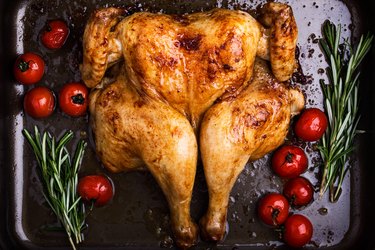
The best way to know if chicken is done cooking is to read the internal temperature with a meat thermometer. But if you don't have one on hand, there are a few other ways to tell it's ready to serve.
All chicken, including fried chicken, grilled chicken and baked chicken breast, should be cooked to a safe internal temperature of at least 165 degrees Fahrenheit, according to the USDA.
Video of the Day
Video of the Day
Ways to Tell Chicken Is Done
There are other ways of testing if your chicken is fully cooked, according to the Australian Chicken Meat Federation (ACMF). One trick involves piercing it, which may be ideal if you're roasting a whole bird and want to know if your chicken is cooked without cutting or tasting it.
To do it, pierce a skewer into the thickest part of the chicken, then observe the juice that seeps out. It should be clear and not pink, an indication of blood or raw, undercooked meat. ACMF also suggests You should also cut into the meat and check that the color is no longer pink or translucent, per the ACMF. Keep in mind some meat, such as ground chicken, may remain pink even when fully cooked through.
The color of the chicken meat may also be an indicator of how cooked it is. Chicken meat should be consistently white when you cut the chicken in half at the thickest part of the cut, according to the ACMF.
What Happens if You Eat Undercooked Chicken?
Eating raw meat such as undercooked chicken can cause a foodborne illness. Symptoms of food poisoning generally start making you feel sick anywhere between six to 24 hours from exposure to the bacteria, at which point you may experience nausea, vomiting and diarrhea, according to the CDC.
Other symptoms of food poisoning include high fever, bloody stool and signs of dehydration, such as dry mouth and throat, dizziness and producing little urine. If these symptoms persist, you should call your doctor.
Children under five, adults over 65, pregnant people and those with compromised immune systems are especially susceptible to foodborne illnesses.
The good news is that it's hard to overcook chicken meat, per the ACMF. You can make tender, moist chicken by cooking it longer at low heat. If you check the color and are still unsure if it's cooked, it's probably best to be safe and cook it for a bit longer. (Read up on common mistakes to avoid when cooking chicken.)
And do yourself a favor: Don't ignore the signs of bad cooked chicken, like a foul odor, slimy texture or white spots, which may indicate bacterial growth.
Chicken Food Safety Tips
Thoroughly cooking chicken to kill harmful bacteria is one safety precaution you'll need to take when preparing poultry. Other safety precautions include cleaning your hands and surfaces often, separating raw poultry from other foods to avoid contamination and immediately refrigerating raw chicken or cooked chicken that isn't being eaten, according to USDA.
Four ounces of boneless chicken breasts should take approximately 20 to 30 minutes to cook at 350 F, per the USDA. The same amount of chicken legs or thighs should take 40 to 50 minutes to cook and wings should take 30 to 40 minutes. It's good to have these times in mind when you're trying to gauge when your chicken will be done cooking.
Always check the expiration date on chicken before bringing it home from the store. Follow the safe handling instructions, keeping the chicken in the package until you're ready to cook it.
Raw chicken can be refrigerated for up to two days and frozen for up to nine months, and cooked chicken can be refrigerated for up to four days and frozen for up to four months, per the USDA.